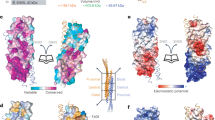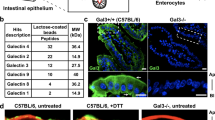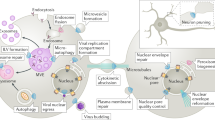Abstract
To perform vectorial secretory and transport functions that are critical for the survival of the organism, epithelial cells sort plasma membrane proteins into polarized apical and basolateral domains1,2. Sorting occurs post-synthetically, in the trans Golgi network (TGN) or after internalization from the cell surface in recycling endosomes, and is mediated by apical and basolateral sorting signals embedded in the protein structure3,4. Basolateral sorting signals include tyrosine motifs in the cytoplasmic domain that are structurally similar to signals involved in receptor internalization by clathrin-coated pits5,6. Recently, an epithelial-specific adaptor protein complex, AP1B, was identified7,8. AP-1B recognizes a subset of basolateral tyrosine motifs through its μ1B subunit7,8. Here, we characterized the post-synthetic and post-endocytic sorting of the fast recycling low density lipoprotein receptor (LDLR) and transferrin receptor (TfR) in LLC-PK1 cells, which lack μ1B and mis-sort both receptors to the apical surface8. Targeting and recycling assays in LLC-PK1 cells, before and after transfection with μ1B, and in MDCK cells, which express μ1B constitutively, suggest that AP1B sorts basolateral proteins post-endocytically.
This is a preview of subscription content, access via your institution
Access options
Subscribe to this journal
Receive 12 print issues and online access
$209.00 per year
only $17.42 per issue
Buy this article
- Purchase on Springer Link
- Instant access to full article PDF
Prices may be subject to local taxes which are calculated during checkout




Similar content being viewed by others
References
Rodriguez-Boulan, E. & Powell, S. K. Annu. Rev. Cell Biol. 8, 395–427 (1992).
Yeaman, C., Burdick D, Muesch A & Rodriguez-Boulan, E. Cell Biology: A Laboratory Handbook 237–245 (Academic Press, 1998).
Keller, P. & Simons, K. J. Cell Sci. 110, 3001–3009 (1997).
Mostov, K., Verges, M. & Altschuler, Y. Curr. Opin. Cell Biol. 12, 483–490 (2000).
Le Gall, A., Yeaman, C., Muesch, A. & Rodriguez-Boulan, E. Semin. Nephrol. 15, 272–284 (1995).
Matter, K. & Mellman, I. Curr. Opin. Cell Biol. 6, 545–554 (1994).
Ohno, H. et al. FEBS Lett. 449, 215–220 (1999).
Fölsch, H., Ohno, H., Bonifacino, J. & Mellman, I. Cell 99, 189–198 (1999).
Robinson, M. & Bonifacino, J. Curr. Opin. Cell Biol. 13, 444–453 (2001).
Owen, D. & Evans, P. Science 282, 1327–1332 (1998).
Bonifacino, J. & Dell'Angelica, E. J. Cell Biol. 145, 923–926 (1999).
Simmen, T., Honing, S., Icking, A., Tikkanen, R. & Hunziker, W. Nature Cell Biol. 4, 154–159 (2002).
Nishimura, N., Plutner, H. & Balch, W. Proc. Natl Acad. Sci. USA 99, 6755–6760 (2002).
Fölsch, H., Pypaert, M., Schu, P. & Mellman, I. J. Cell Biol. 152, 505–606 (2001).
Girotti, M & Banting, G. J.Cell Sci. 109, 2915–2926 (1996).
Roush, D., Gottardi, C., Naim, H., Roth, M. & Caplan, M. J. Biol. Chem. 273, 26862–26869 (1998).
Maxfield, F. R. & Yamashiro, D. J. Intracellular trafficking of proteins. (eds Steer, C. J. and Hanover, J. A.) 157–182 (Cambridge University press, Cambridge, 1991).
Gottardi, C., Dunbar, L. & Caplan, M. Am. J. Physiol. 268, F285–F295 (1995).
Hunziker, W., Harter, C., Matter, K. & Mellman, I. Cell 66, 907–920 (1991).
Matter, K., Hunziker, W. & Mellman, I. Cell 71, 741–753 (1992).
Matter, K., Yamamoto, E. M. & Mellman, I. J. Cell Biol. 126, 991–1004 (1994).
Koivisto, U.-M., Hubbard, A. & Mellman, I. Cell 105, 575–585 (2001).
Maxfield, F. R., Schlessinger, J., Shechter, Y., Pastan, I. & Willingham, M. C. Cell 14, 805–810 (1978).
Odorizzi, G. & Trowbridge, I. J. Cell Biol. 137, 1255–1264 (1997).
Futter, C. E. et al. J. Cell Biol. 141, 611–623 (1998).
Wang, X.,, Kumar, R., Navarre, J., Casanova, J. E. & Goldenring, J. R. J. Biol. Chem. 275, 29138–29146 (2000).
Brown, P. et al. Traffic 1, 141–151 (2000).
Aroeti, B. & Mostov, K. EMBO J. 13, 2297–2304 (1994).
Matter, K., Whitney, J., Yamamoto, E. & Mellman, I. Cell 74, 1053–1064 (1993).
McGraw, T. & Subtil, A. Endocytosis: biochemical analyses (John Wiley & Sons, New York, NY, 1999).
Acknowledgements
This work was supported by National Institutes of Health grants GM34107 and EY08538 and by a Jules and Doris Stein Professorship from the Research to Prevent Blindness Foundation to E.R.B., and by NIH grants DK-52852 and DK-57689 to T.E.M. We thank I. Mellman, H. Fölsch and J. Bonifacino for providing several constructs and antibodies. We thank I. Mellman and members of the Rodriguez-Boulan laboratory for critically reading the manuscript.
Author information
Authors and Affiliations
Corresponding author
Ethics declarations
Competing interests
The authors declare no competing financial interests.
Supplementary information
Supplementary Figures
Figure S1. Double immunofluorescence localization of µ1B and endosomal markers rab-5 and rab 11. (PDF 499 kb)
Figure S2. LLC-PK1 monolayers on filters are impermeant to antibodies.
Rights and permissions
About this article
Cite this article
Gan, Y., McGraw, T. & Rodriguez-Boulan, E. The epithelial-specific adaptor AP1B mediates post-endocytic recycling to the basolateral membrane. Nat Cell Biol 4, 605–609 (2002). https://doi.org/10.1038/ncb827
Received:
Revised:
Accepted:
Published:
Issue Date:
DOI: https://doi.org/10.1038/ncb827
This article is cited by
-
LDLR is an entry receptor for Crimean-Congo hemorrhagic fever virus
Cell Research (2024)
-
The fast-recycling receptor Megalin defines the apical recycling pathway of epithelial cells
Nature Communications (2016)
-
Organization and execution of the epithelial polarity programme
Nature Reviews Molecular Cell Biology (2014)
-
The kinesin KIF16B mediates apical transcytosis of transferrin receptor in AP-1B-deficient epithelia
The EMBO Journal (2013)
-
KIF16B delivers for transcytosis
The EMBO Journal (2013)



